Are you tired of making separate, special meals for your baby? Or are you unsure of how to make your own family meals baby friendly? Maybe you’re also worried about offering your baby certain foods out of fear they could choke and you just aren’t sure if they can handle these “adult” foods yet.
Instead of having to stress about making different meals for you and baby, I’m going to teach you how to modify your own family meals to make them perfect for baby, which will save a ton of time, planning, and headaches about what to serve.
If you need some new meal ideas for the whole family, check out my 60 Day Baby Led Feeding Meal Plan – you’ll get access to over 80 recipes that are the perfect meals for starting solids. This isn’t just a regular meal plan with a list of recipes. You’ll actually be able to follow along with the plan to strategically introduce allergens, advance your baby in textures, and ensure all nutrient needs are being met.
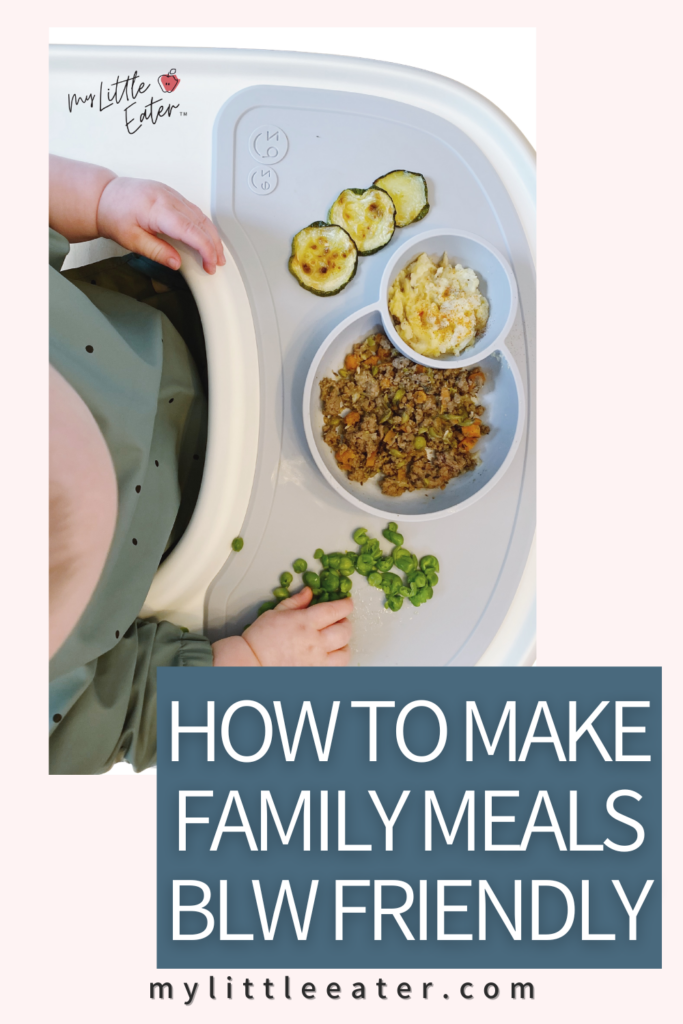
You may have some questions or concerns about this, like:
- What age can babies eat the same food as their family?
- Do I have to be careful with certain ingredients?
- What should I cook that’s healthy for baby and the entire family?
I’ll walk you through everything you need to know about modifying your own family meals to make them baby friendly. As an added bonus, we’re going to look at 5 different meal ideas and how to modify them appropriately for baby to show you how easy it can really be!
If you’re feeling stressed or scared about introducing more textured foods and finger foods, register for my free workshop, “Baby Led Weaning…but make it purées! How to move from purées to finger foods – without the fear!” You’ll learn all about gradually moving from easier to more advanced textures while overcoming fears about gagging and choking. Save your spot now!
Table of Contents
At what age can babies eat the same food as the family?

It’s absolutely possible to serve your baby – even your little 6-month-old – the same food that you’re having. Meals YOU actually enjoy too! You really don’t need special “baby recipes” to make them the perfect meal when you start solids, trust me. In the beginning stages of baby led weaning, around 6 months of age, it’s typical to start out with really soft and simple foods to see how your baby will manage with solid food. For the first few meals, it’s ok to offer easy-to-prepare first foods, since they won’t be eating a whole lot in the beginning.
But once they’ve had a couple of practice meals with solids, it’s go time! You can start offering more complex foods with different flavors, textures, and spices. There are endless possibilities here and what you offer will depend on foods that are typically eaten by you and your family. This can be anything from meatloaf, to toast with hummus and everything in between! I encourage you to get creative and give them ample opportunities to explore new foods.
Benefits of you and baby eating the same family meal

There are so many benefits to you and baby eating the same meal. It provides more opportunities for exposure to essential nutrients, textures, and flavors. It can also help with learning how to eat and modeling healthy eating behaviors in general. Read my blog about setting up feeding schedules by age so you can coordinate your baby joining in on your family mealtimes.
First, let’s talk about the nutrients. The variety of different nutrients, including iron, protein, healthy fats, vitamins, and minerals your baby will get from eating family meals will likely be superior to continuing to serve baby the typical first foods, like banana, avocado, bread, etc. It’s easy to get stuck in a cycle of these more simple foods because they’re easier to prepare and easy for your baby to eat, but it’s important to expose baby to as much variety as possible early on when they start solids.

The second benefit of baby partaking in family meals (instead of the typical baby led weaning foods like toast, puffs, sweet potato, and yogurt), is that it will make it much easier to introduce different food combinations and foods with different flavors, textures, and spices. Exposing baby to a variety of foods will help with expanding your baby’s palate and the types of food they will accept long term.
Finally, not only is it extra work to make one meal for you plus a separate baby recipe – it’s also not helpful to be eating different foods from your baby from the perspective of modeling eating behavior! We know that it’s important to sit with your baby while they’re eating so you can show them things like how to chew food, take bites, and swallow. It becomes easier for babies to join in and imitate you when they see you’re also eating the same foods as them! Watching you eat the exact food that is on their plate also allows them to see that the food is safe and appealing, and may help them see the foods as something they want to explore.
How can I make my own family recipes baby friendly?

Even though you can offer your baby what everyone else is eating, you still have to do so safely and ensure that it contains safe ingredients. To make sure food is safe for your baby, you’ll need to make modifications to the shapes and sizes of foods based on your baby’s age and individual skill level.
It’s also understandable that you may have some concerns about the amount of salt you add to your recipes, sweet ingredients like sugar and sweeteners, or certain spices that you use.
I want you to be confident in modifying your family meals for baby, so let me guide you on how to make baby friendly choices when you’re preparing your own family recipes.
Avoiding added salt while cooking

We want to avoid high amounts of added salt for babies. There is a recommendation of limiting your baby’s sodium intake to 400 mg per day, but there isn’t a ton of research to back up that number. There’s also no good evidence out there to confirm the development of kidney disease or any other health issues related to salt intake, if your baby has a little bit of salt in their food, especially if it’s from whole foods (1).
If you’re interested in knowing more about the research on salt for babies to date, check out my blog on the truth about salt for babies, here.
Whole foods are a superior option for your baby, as processed foods contain many added and unnecessary ingredients (aside from the high amount of salt) that aren’t beneficial to their health. Processed foods to limit or avoid include deli and other processed meats, canned soups and sauces, crackers, and cereals. Even nut butter or yogurt can have added ingredients that add up throughout the day, so avoiding flavored or more-than-necessary processed versions of these foods is better.

The bottom line is when you’re preparing mostly family meals from scratch, it really isn’t a big deal to add a little bit of salt while cooking your food to enhance flavor. You shouldn’t stress about counting every tiny milligram of sodium found in your baby’s portion – this would drive you crazy along with all the other things you have to worry about when feeding your baby. Generally, it’s more about the quality of food you’re offering baby. The most important thing to keep in mind is to keep processed ingredients to a minimum or avoid them most of the time, if you can.
Now, if you’re busy or in a rush and need a quick meal for your baby sometimes, a good rule of thumb is to look for pre-made food or ingredients with less than 100 mg of sodium per serving and/or balance it out with other very low sodium foods over the next day or two. Many canned goods like beans, vegetables, and fish (like canned salmon) are available with no added salt – so these are good options if you need to make a quick meal.
Should I avoid sugar and other sweet ingredients in baby led weaning recipes?

It’s best to avoid or strictly limit added sugar for babies (including artificial sweeteners like stevia). Sugar contains no nutritional value or benefit, causes blood sugar spikes and with infants’ innate preference for sweet taste, exposing them to extra sugar and lots of sweet foods early in life can lead to reduced diversity of food preferences later on (2).
Sugar-filled foods with little nutritional value will also displace room in your little one’s belly for other nutrient-dense foods that your baby needs for optimal growth. Children who consume too much sugar are also at risk for developing a whole slew of potential health issues like obesity, dental caries, increased risk of type 2 diabetes, poor heart health, and more (2).
Remember that natural sugar from whole foods like fruits and dairy products is totally ok! The important thing is to avoid foods with added sugars (typically indicated on the nutrition facts table), like flavored yogurts for example. The natural sugars found in plain yogurt are ok.

Also, things like maple syrup and agave syrup are sometimes added to foods to increase sweetness. These should be avoided because even though they’re considered a natural source, they are an added source of sugar.
Honey is a food you’ll want to avoid completely until at least 12 months of age. This includes all forms of honey whether it’s pasteurized or unpasteurized, in a baked good, or on its own. The reason for this recommendation is there’s a risk that honey contains spores of bacteria, which can cause infant botulism (3). This is rare but potentially fatal, so it’s important to pay attention to packaged products and baked goods. Always read the ingredient lists carefully before offering prepackaged foods to your baby.
What about recipes that include alcohol as an ingredient?
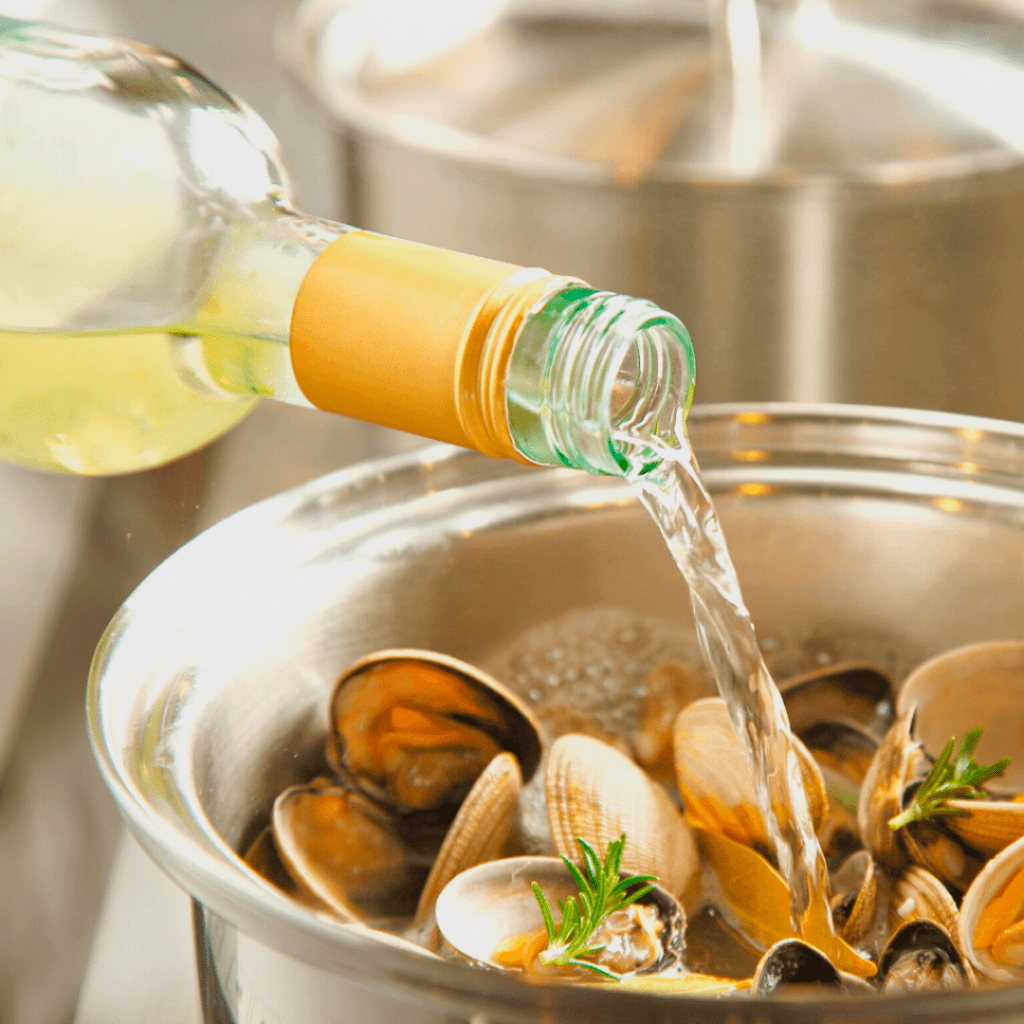
Alcoholic drinks like wine and beer are sometimes used in recipes to add flavor. Whether or not your baby can have foods that have been prepared with alcohol as an ingredient depends on a few different factors, like the strength of alcohol used, the amount of alcohol in the dish, the method of cooking you choose, and how long you’ve cooked or simmered the dish (4).
Since there are so many varying factors involved, it’s tricky to make a specific recommendation. The safest option is to avoid adding alcohol to recipes if you want to serve them to your baby. But you’re the parent, so it’s ultimately your choice on whether or not you’re comfortable serving a dish that has been prepared with a very little amount of an alcoholic beverage if it’s been simmered down for a long time.
I also want to mention vanilla extract, as some types do contain very small amounts of alcohol. Pure vanilla extract can contain 35% or more alcohol content. Artificial vanilla extract can have as little as 2% alcohol content. While vanilla extract is safe for your baby, you can opt for brands that are alcohol-free just to be safe.
Can I offer my baby a recipe made with spices?
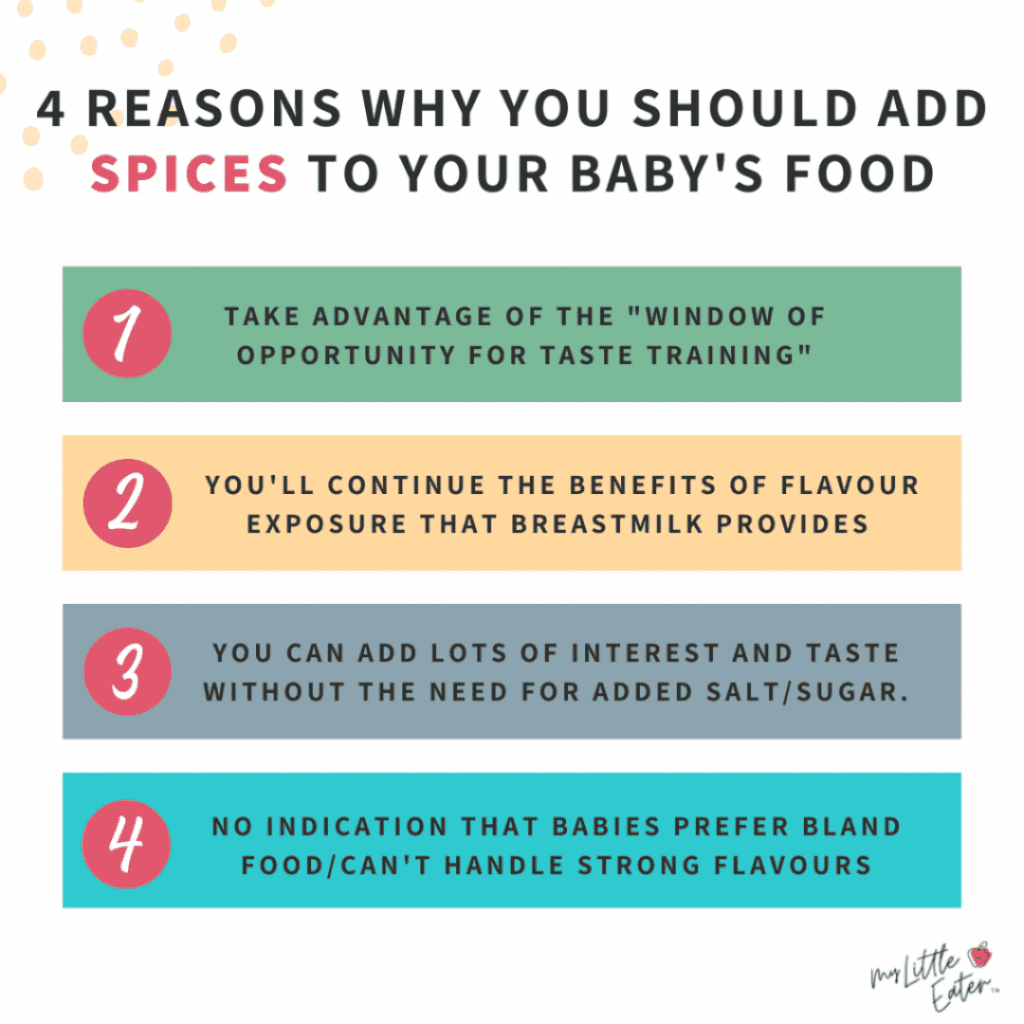
It’s absolutely ok to add spices to your baby’s food right from the beginning – and I actually recommend you do! Babies have a window of opportunity between 6 to 9 months of age when their taste buds are in “training”. Introducing your little one to a variety of flavors and different spices early on in the beginning stages of starting solids will reduce the chance of them being picky later on (5).
Picky eating can start as early as 10 months of age, so be sure to take advantage of that short critical window to develop their taste buds and expose them to as much variety as possible.

There’s no reason you should hold out on spices like curry, cumin, oregano, turmeric, cinnamon, mint, basil…and so on. Remember that babies growing up in different cultures all over the world eat Thai food, Indian food, Mexican food, etc. They’re all getting exposure to various spices depending on the local cuisine. So there’s no need to keep your baby’s food bland and one-dimensional.
The only time I would recommend setting aside ingredients for baby is if you’re making a really spicy (aka hot spicy) dish, for example, one containing a lot of cayenne pepper or actual hot peppers (ie. jalapeño). This could be irritating for your baby and may make it hard for them to actually eat the meal. You can start with small amounts, and as the months go on, gradually increase the amount of heat as they tolerate it.
Other than that, I encourage you to get creative and try serving your baby different types of cuisine to allow for ample exposure to flavors and textures.
Choose ingredients that meet their nutritional needs

When preparing family meals, keep in mind that babies have different nutritional needs than adults. They require high calorie foods, high iron foods, and it’s good to always have produce present for exposure purposes as these are foods that are the first to typically be dropped in toddlerhood.
We want babies to have the most nutrients/calories per bite, so choosing meals with foods that will give them lots of energy via healthy carbs or healthy fats is going to be important. An example of a high-fat food swap to take note of in a family meal is to choose full-fat dairy products instead of low-fat products (whenever possible). This means things like cheese, yogurt, and milk products. Babies need a lot of fat in their diet to provide the calories needed for optimal growth. We recommend choosing full-fat dairy products for your little one at least until 2 years of age.
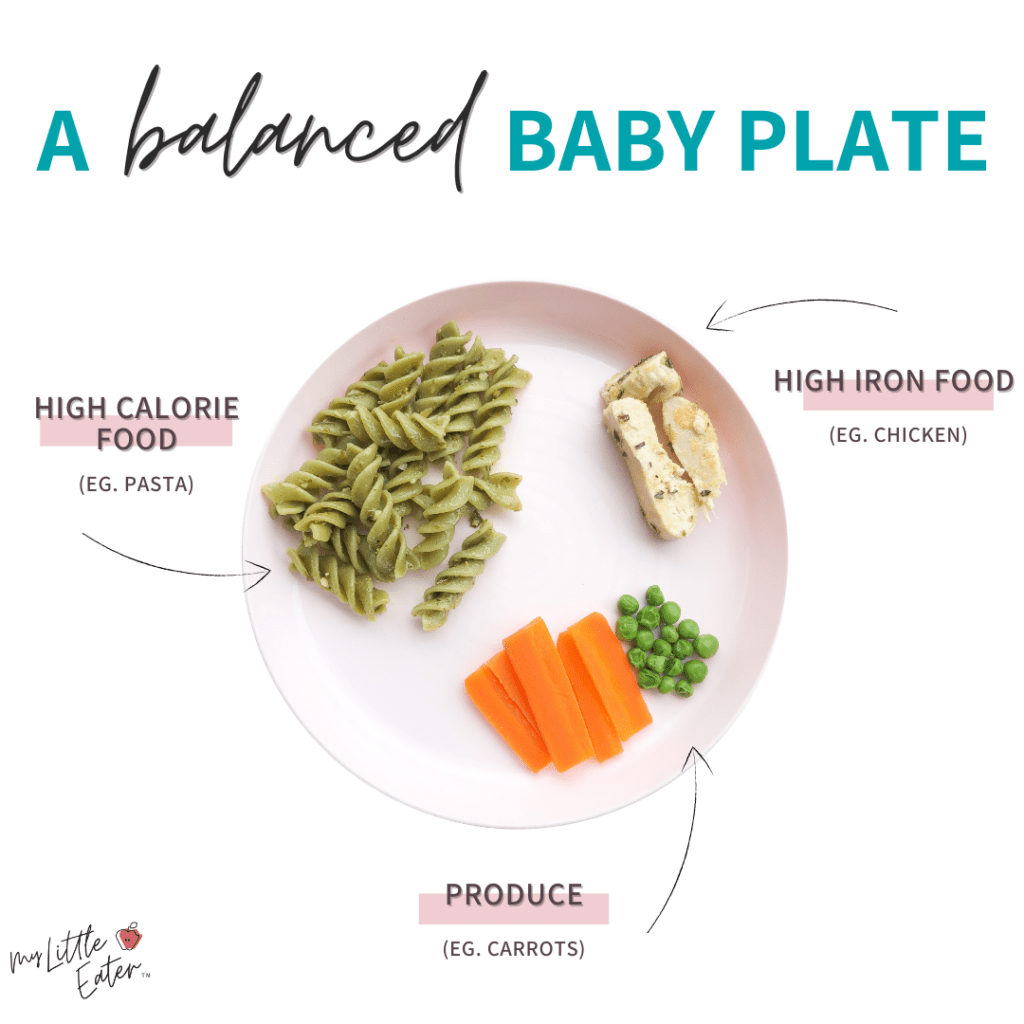
High-calorie foods that provide them with lots of useable energy are starchy foods like potatoes, bread, rice, carrots, corn, pasta, etc. These are high in carbohydrates and give them easily used forms of energy to sustain them.
Ensuring family meals contain a good source of iron is also important. You don’t have to have this every single meal, but at least 2 of 3 meals offered should have a food high in iron like chicken, ground beef, pork, tofu, beans, chickpeas, or lentils. Be sure to pair non-heme sources of iron, such as beans and tofu, with something high in vitamin C to increase absorption, such as drizzling lemon juice on top of beans. See this blog for more high iron food ideas and info.
Finally, if and when possible – have a fruit or vegetable present on the side or as a component of your family meal. Again – perfection isn’t the goal. But it’s one of the things to keep in mind that helps your baby achieve their nutritional needs (plus is good to do for the whole family as well!).
Note: All meals in our 60 day Baby Led Feeding meal plan are perfectly balanced family meals that meet the nutrient needs of baby too!
Introduce meals with allergenic foods strategically
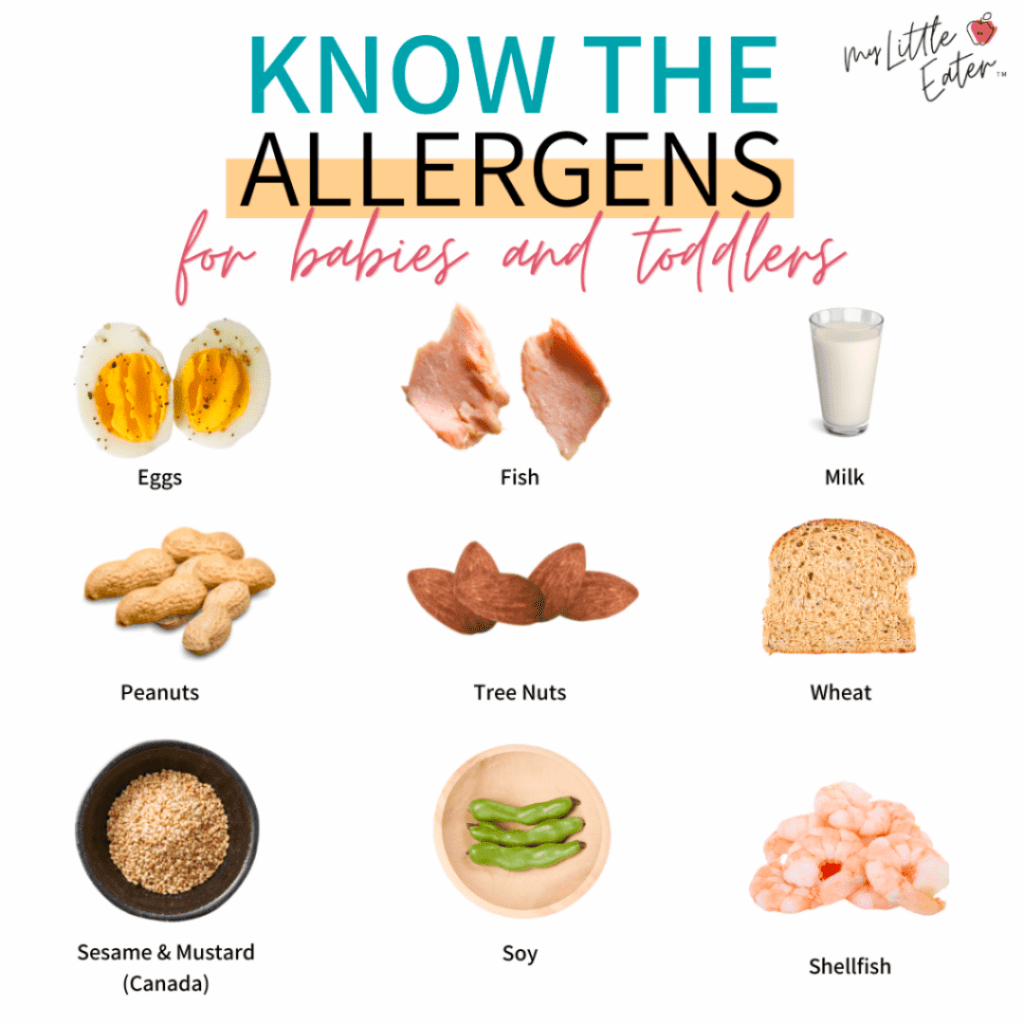
The first few weeks of introducing solids to your baby can be tricky, as highly allergenic foods must be introduced strategically so if any allergic reactions occur you can isolate the food that caused it.
This makes planning meals for the whole family a little difficult due to the possibility of multiple allergens being included in a meal, like a casserole for instance. You may not know how to introduce allergens strategically or if your baby can even have certain allergens that are included in your family recipes.
Introducing common allergenic foods to your baby can be confusing because the recommendations have changed over the years. The most recent recommendation is to introduce common allergens around 6 months of age, or very soon after your baby starts solids (6). There is no benefit to delaying introduction of allergenic foods and research states that waiting could actually promote the onset of allergies (6). The bottom line is to offer allergens early on and keep offering them often throughout childhood.
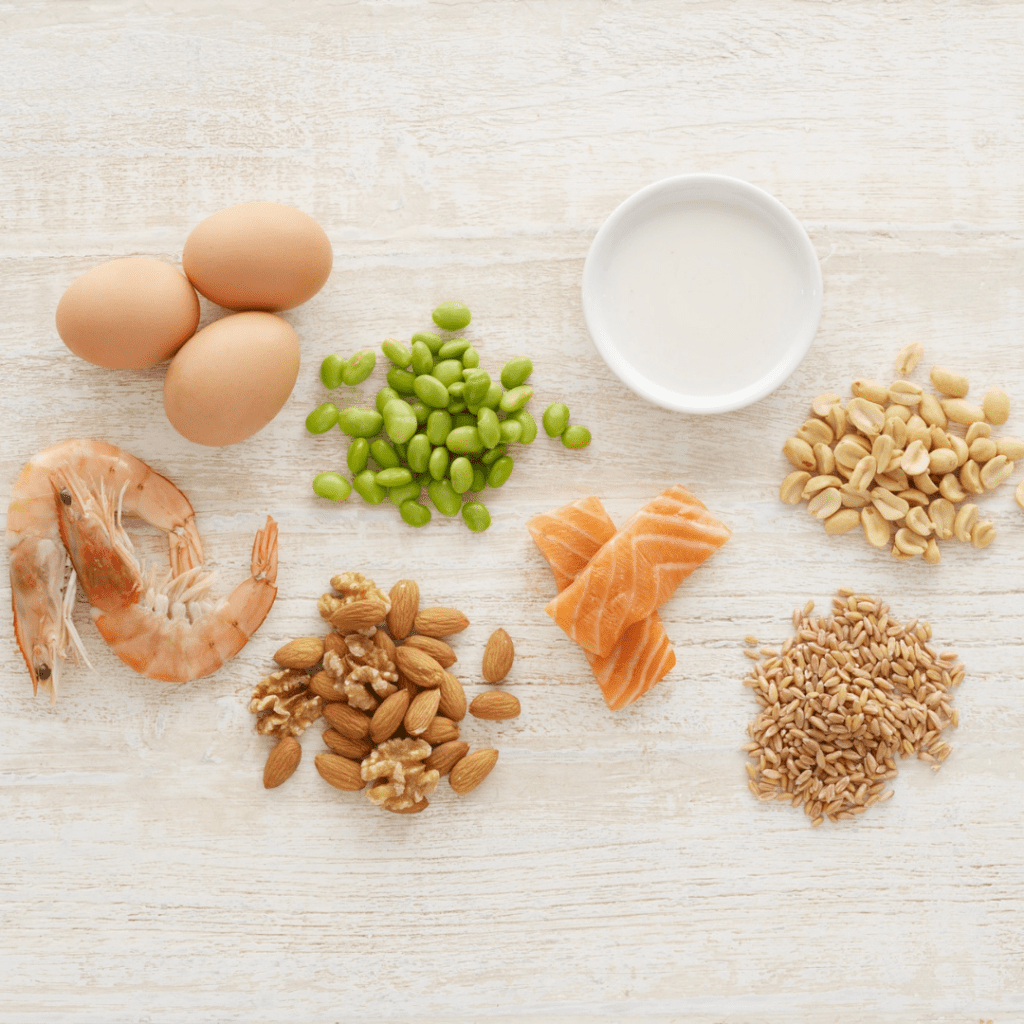
The recommendations are a bit different if your child is considered at high risk for developing a food allergy. I explain all the details (including symptoms) in my blog on introducing highly allergenic foods.
If you need guidance on what to feed your baby when they start solids, check out my 60 Day Baby Led Feeding Meal Plan – you’ll get access to over 80 healthy recipes, that the whole family will love! This isn’t just a regular meal plan with a list of recipes, you’ll actually be able to follow along with the plan to strategically introduce highly allergenic foods.
When I developed this meal plan, I made sure to include as many of these allergens as I could! Each allergen is highlighted on the days it’s included and will be introduced two days in a row to make sure there is no reaction after the initial exposure, followed by a break before introducing a new one.

5 popular family meals modified for babies

There are so many easy things you can do to modify your current family meals, making meals less stressful for you and more inclusive for your baby! The most important thing to remember is to modify meals to be safe, healthy, and easy for baby.
One of the most important parts of making your family meals perfect for baby is that you need to make it easy for your baby to pick up and hold.
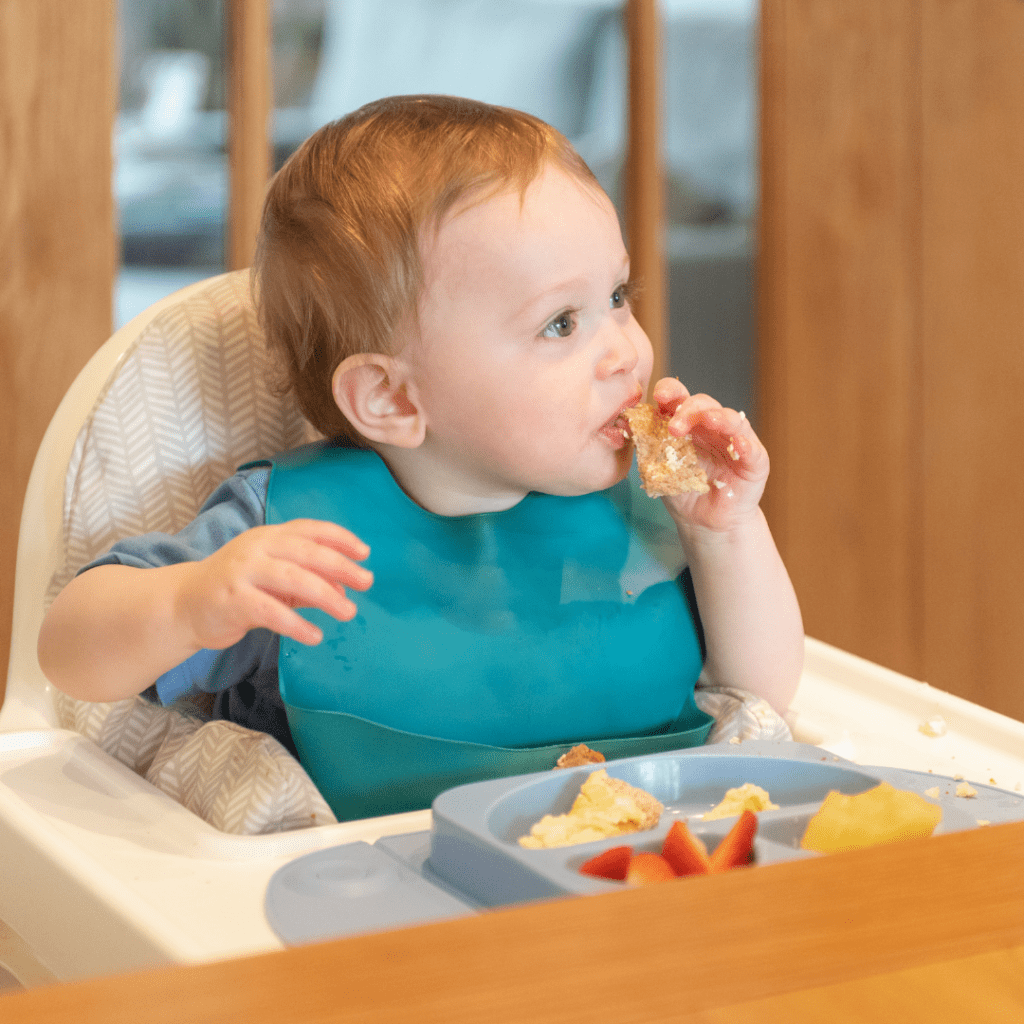
Here are some tips for how to do this:
- Deconstruct ingredients into really large shapes like strips, wedges, or rounds, for baby to pick up and eat. For example, serve pancakes, french toast, and whole grain toast cut into finger shapes or thin strips.
- Foods like grains or rice can be tricky for babies, so a good way to serve these foods is to mix it with a purée (hummus, plain Greek yogurt, mashed sweet potatoes, etc.) and serve it on a preloaded spoon.
- Use grain toast as a vehicle for hard-to-eat foods. For instance, beans would be hard for a baby to pick up without their pincer grasp, but mashed beans on lightly toasted bread will be much easier for baby to pick up and hold. Another example is to serve nut butters like almond butter on toast as a very thin layer because serving them on their own (like on a spoon for example) is considered a choking hazard for babies.
One more thing to keep in mind is that when serving meat, it should always be very tender, moist and soft for baby. Methods like slow cooking meat are a great way to ensure meat will be safe for baby.
Learn more about the most tender cuts of meat for babies.
Note: If you’re starting with purées, your baby can still be eating what you eat – you just have to blend it first! Follow my resource guide on How to Make Puréed Baby Food, found inside my Baby Led Feeding online course, for more details!
Baby friendly family meals: Soup
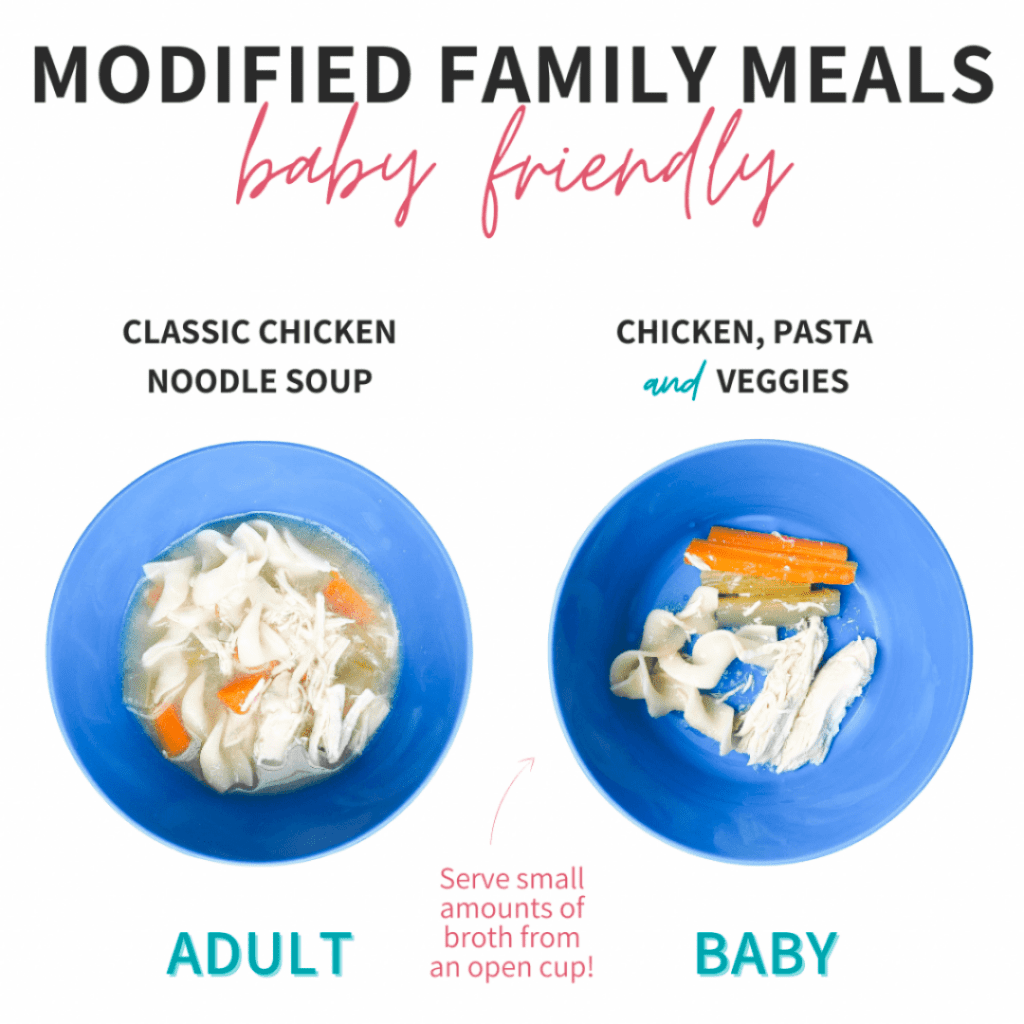
Soup is one of my favorite hearty meals when the cold weather starts to creep in! It’s easy to make and can be pretty nutritious depending on what you add!
Did you know you can also serve soup to babies right when they start solids?! That’s the beauty of offering whole foods early – your baby can dive right into family meals without much extra prep work whatsoever!
Since most babies under 12 months will struggle scooping soup out with a spoon, make sure when prepping the soup that you cut the meat and veggies in bigger pieces so they’re easier for baby to grab and hold.
Make sure veggies and meat are both very soft, with the meat being tender. Meat and veggies that have been stewed are a great soft option for babies just starting out!
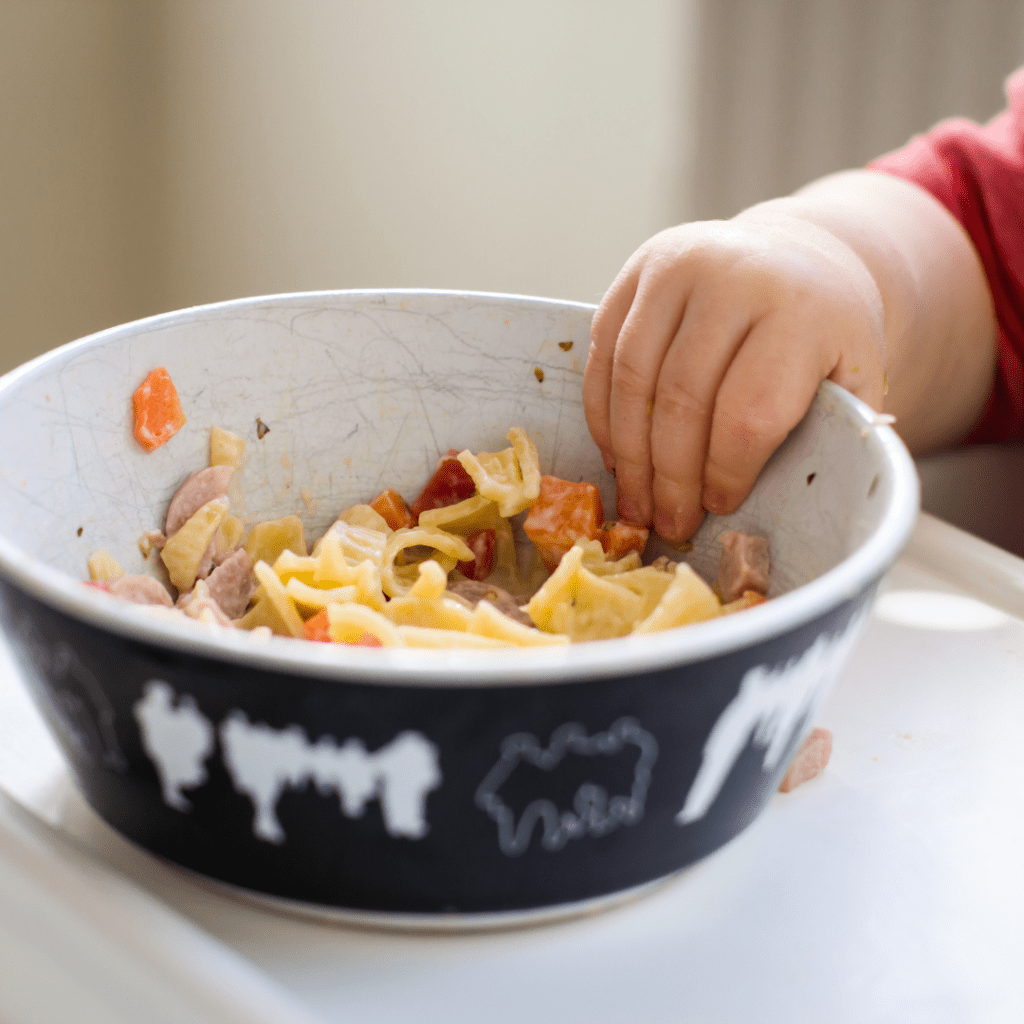
At 6 months:
Strain out the broth and serve finger length pieces of meat, noodles, and veggies right on the tray or in a bowl. For practice, try serving a small amount of broth in an open cup.
At 9 months:
Strain the liquid out and offer the meat, veggies, and pasta cut up in smaller, diced pieces to help them practice their pincer grasp! Serve a small amount of the strained broth in an open cup.
If serving broth in an open cup, limit the amount to no more than 1-3 oz per day for babies under 12 months of age.
At 12 months and beyond:
There isn’t much modifying needed here when you compare this to what you would eat, with the exception of only including a small amount of liquid. You can continue to serve small amounts of broth in an open cup, as well. At this stage, you can offer a utensil and give them more practice with scooping pieces out of the bowl on their own!
Baby friendly family meals: Stew or Chili
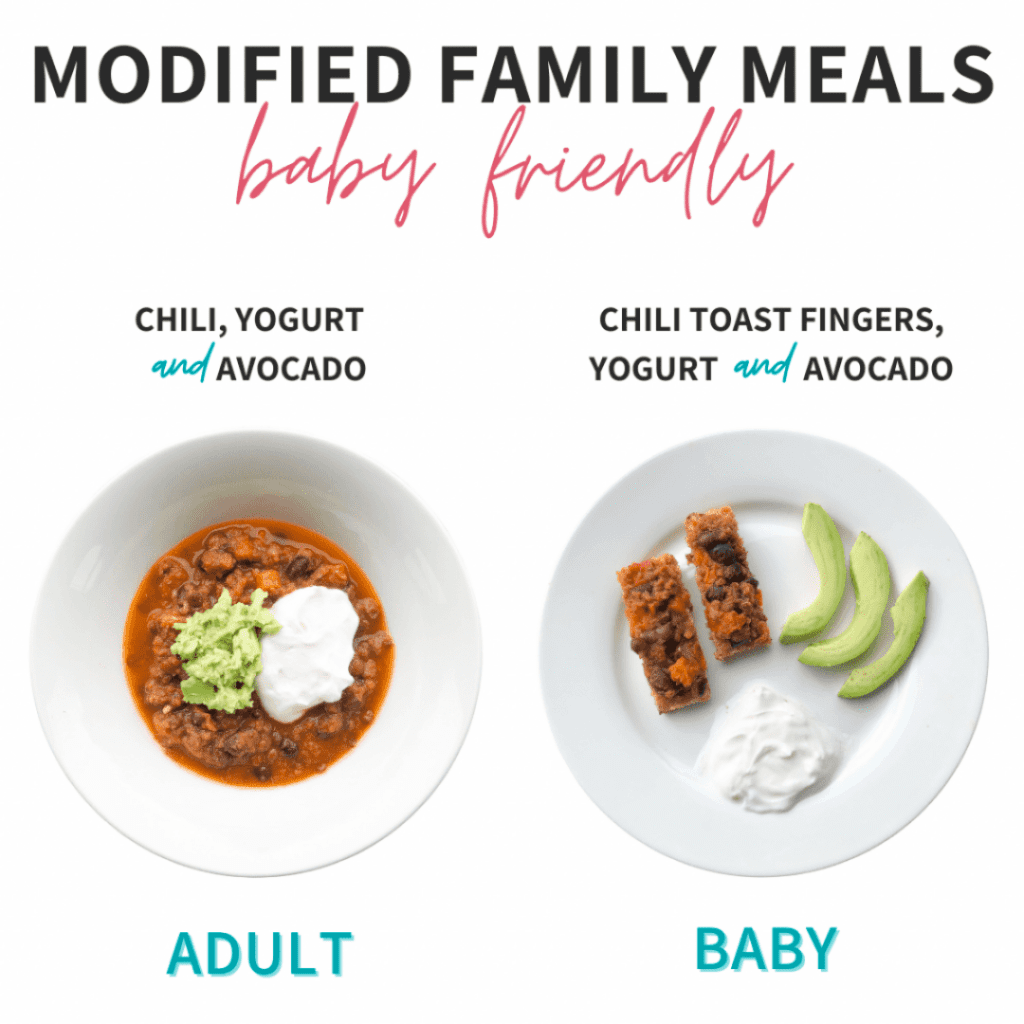
Chili and other dishes like stews are a great, nutrient-dense meal option for the entire family, especially since they are generally high in iron and a good source of protein for your baby! But chili can be challenging depending on your baby’s age, especially since babies only have palmar grasp until around 9 months and can’t pick food up using utensils yet.
At 6 months:
Offer the chili mixture on a piece of lightly toasted bread. Cut them into finger shapes so it’s easier for your baby to pick up and self-feed!
Offer toppings, like plain Greek yogurt and avocado, on the side instead of high-sodium sour cream and cheese. Cut the avocado into finger-length wedges and offer plain yogurt as a dip so they can dip the toast, or their fingers, in it!
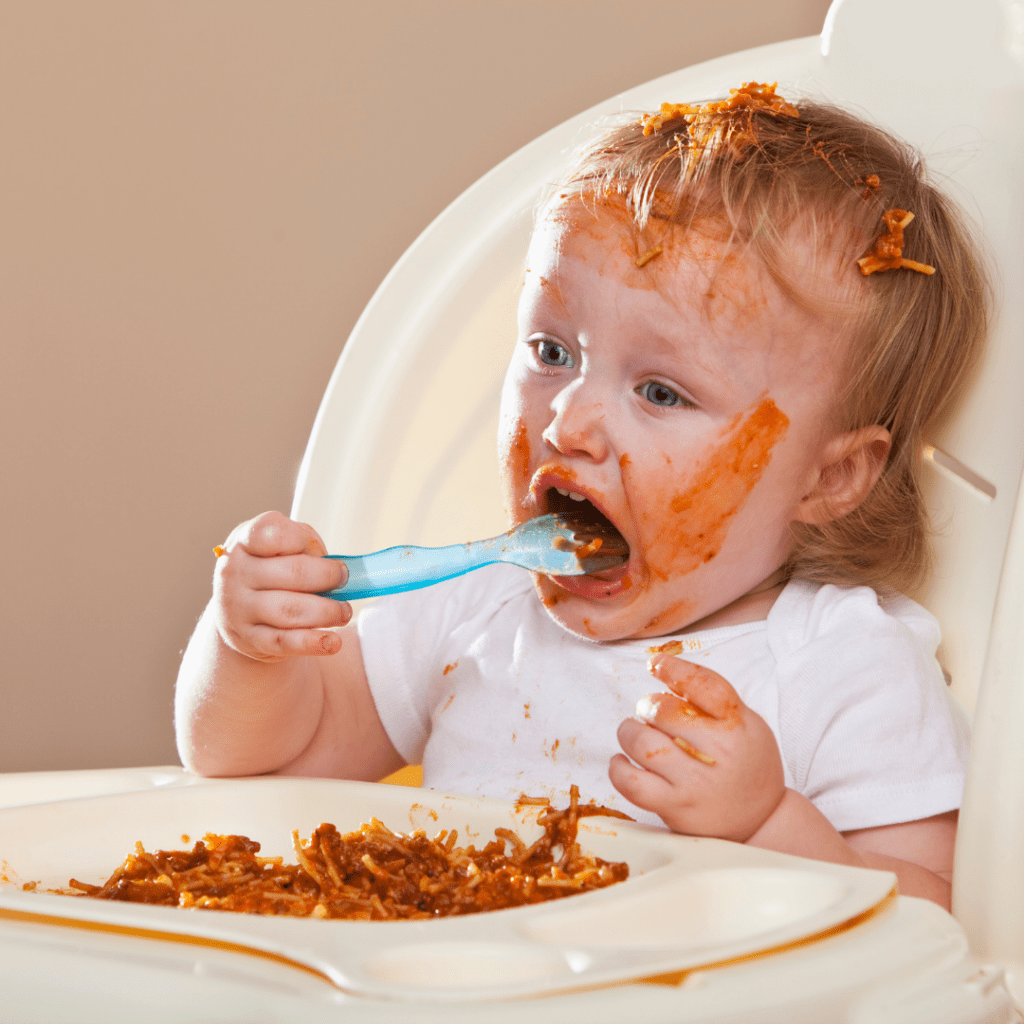
At 9 to 12 months:
If your baby has their pincer grasp you could offer some of the larger pieces of the chili on a plate as well so they can practice using their pincer grasp and pick them up. You can also mix the chili into another food that’s a bit thicker, like mashed potato, and serve it on a preloaded spoon, or again, let them eat it using their hands!
Baby friendly family meals: Wraps, fajitas, tacos, and sandwiches
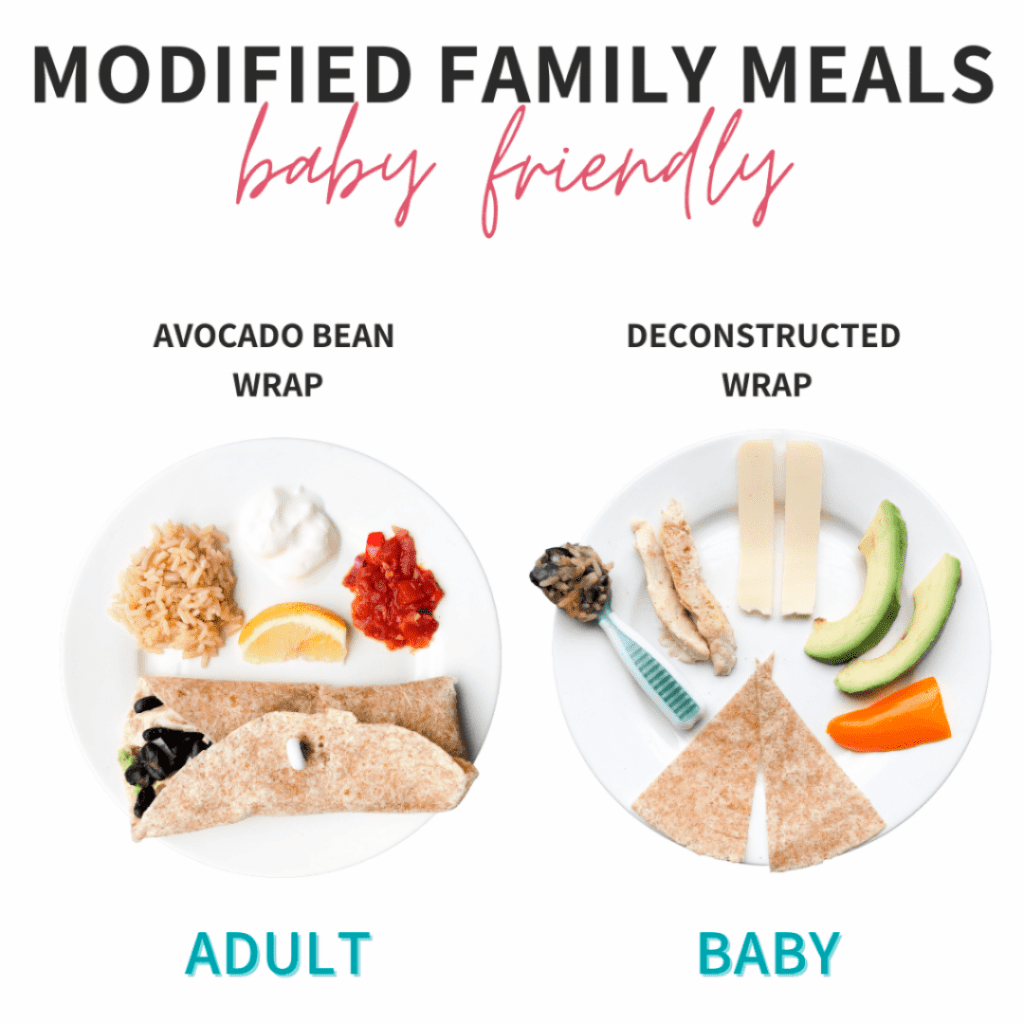
You might be thinking, how in the world could I serve my baby a taco, fajita, or wrap? At first, it sounds ridiculous, but you can definitely serve these types of family meals to babies safely by deconstructing the components into long strips so that it’s easy for baby to pick up, hold, and eat.
Sour cream and jar salsa are typical pairings for tacos and fajitas, but these tend to be highly processed and too high in salt to serve to your baby. A great option in place of sour cream is plain Greek yogurt – which can be used to add moisture to foods like tortillas.
At 6 months:
Deconstruct and modify each component into long strip forms for easy grip. Cut the wrap, cheese, chicken, avocado, peppers, carrots, etc. into long pieces. Chicken should be cooked very tender (as should all meat). Vegetables should be served in their raw, whole form as a highly resistive food (only for babies with no teeth) or they can be served cooked, provided they are very well roasted and soft. Serve hard-to-grasp foods, like rice or taco meat, with mashed beans or avocado on a preloaded spoon.
To learn how to serve all of these types of foods safely, check out my Baby Led Feeding online course and the Texture Timeline™ Food Library that’s inside!

At 9 to 12 months:
If your baby has their pincer grasp, you could offer small bite-sized pieces of the wrap, taco, or sandwich filling on a plate so they can practice using their pincer grasp and picking up smaller pieces. These foods should be prepared so they’re soft enough for baby to mash between their gums (cooked soft carrots and tender chicken for example). Again, you can also serve those hard-to-grasp foods (like rice, taco meat, etc.) on a preloaded spoon, or let them get messy and use their hands!
Baby friendly family meals: Lasagna

Lasagna, yum. Normally it’s served with lots of cheesy layers, meat, and noodles. But this doesn’t really work so well for a baby who is trying to pick up and hold their food. But, I’ve got an easy way for you to modify it so that you don’t have to worry about cooking that separate baby meal for your little one.
At 6 months:
Try a lasagna noodle roll-up! Cut lasagna noodles in 1/3 or 1/4’s widthwise, spread the cottage cheese or other soft cheese filling on the noodle, and roll it up. Cover in sauce and cook. Substitute for lower sodium cheese where possible, like ricotta cheese and/or reduce mozzarella and parmesan cheese. The lasagna roll will be much easier for your baby to pick up and hold with their palmar grasp.

At 9 to 12 months:
If your baby has their pincer grasp, you can offer different components of the lasagna in smaller bite-sized pieces. Try small pieces of hamburger and bite-sized pieces of pasta noodle with some cheese spread on top. You can continue to serve it as lasagna roll-ups, but you want to give them the opportunity to practice that pincer grasp if they haven’t mastered it yet!
Baby friendly family meals: Salad
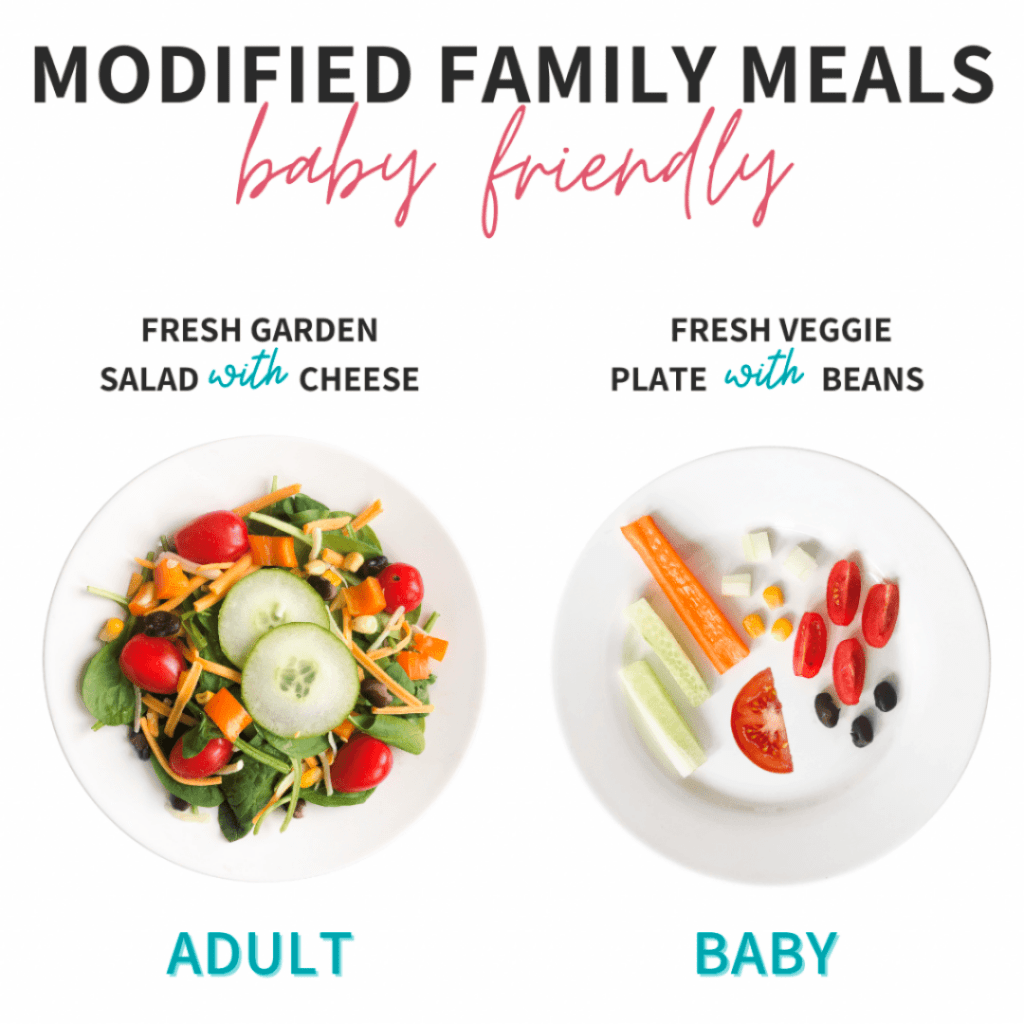
Again, you may not think of salad as something you can safely serve to your baby when they start solids. You may have also heard that leafy greens are a choking risk until 4 years old. However, raw leafy greens can also be modified to eat earlier (around 12 months of age). Before 12 months of age, raw leafy greens are a choking hazard, so eliminate them until then.
At 6 months:
Pick out bigger pieces of vegetables, or other ingredients, that are safe in size and offer those. Think oversized pieces of highly resistive, whole foods they would be able to hold with their palmar grasp (i.e. asparagus stalk, lettuce rib, whole raw carrot, raw celery, etc.). These are considered phase 0 foods on my Texture Timeline™. You can also offer ultra-thin sliced cheese in a long strip form.
At 9 to 12 months:
Offer small diced pieces, like the soft inner portions of cucumbers, or quartered cherry tomatoes, that they can eat with their pincer grasp. You can also offer shredded cheese in a mini hay stack or bite-sized ultra thin slices. Try adding corn kernels or beans or cooked green beans to your salad – it gives added nutrients for you and baby!
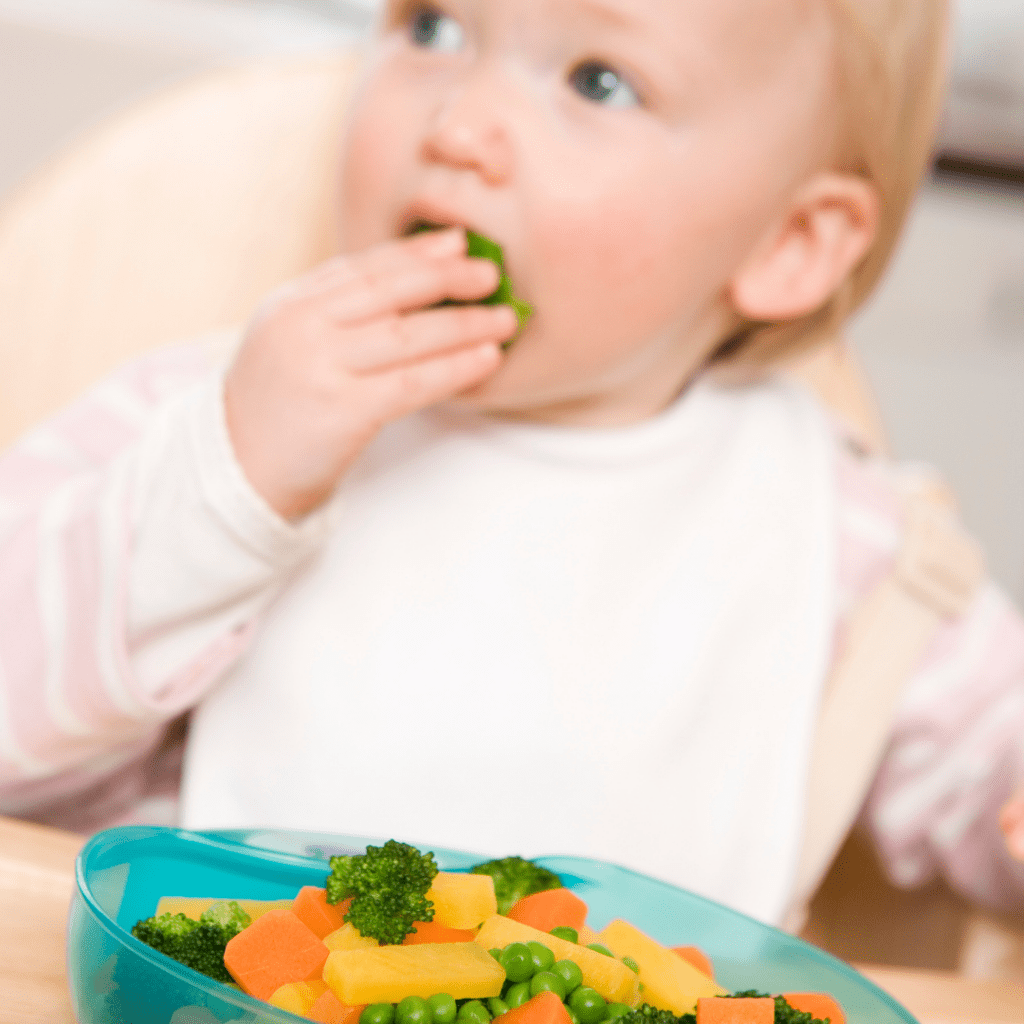
After 18 months:
When your toddler has developed a rotary chew, you can offer the center (rib) of a lettuce leaf. Your toddler can bite into it, and break it down over their molars using up and down munching motions. You can also offer more crunchy lettuce like iceberg, shredded into thin pieces. Then move them onto slightly thicker shreds of other types of lettuce, spinach, kale, etc. Add olive oil or salad dressing to make it easier and more palatable!
Note: a raw lettuce rib is a highly resistive, whole food that is safe for a baby to munch on at 6 months of age as they should not be able to break off any pieces. Therefore, it’s good for oral exploration and development. But, this is only safe until they have teeth, because they are then able to break off a chunk and this increases the risk of choking. Once baby has teeth, avoid serving the lettuce rib until they have developed the rotary chew around 18 months of age.
Other baby friendly family meal ideas

The possibilities are endless when it comes to making family meals your baby can eat too! There will almost always be a few simple modifications or switches you can make to have your baby eating the same foods as you. Again, this will be beneficial for your little one down the road in terms of acceptance of new foods, picky eating, and developing a healthy relationship with food.
My baby led feeding meal plan is FILLED with meals for the whole family that are already perfect for baby! Some of my top favorites include chicken curry rice cups and apple sage beef burgers! With the meal plan, you’ll get access to over 80 recipes, nutritious and delicious recipes that aren’t just for babies but that you can actually feed to your whole family!
And if you’re looking for more help for starting solids with your baby, and are ready to feel confident in knowing what to feed your baby and how to do it safely, be sure to check out my Baby Led Feeding online course for everything you need to know! I’ll walk you through starting solids with your baby, step-by-step, using whichever method you feel comfortable with to start and teach you how to gradually progress from there. Don’t spend this important milestone stressed out and worried – actually enjoy meals with your baby instead!

DID YOU FIND THIS HELPFUL? PIN IT TO SAVE FOR LATER!

References:
- Lily Nicholas, RDN. Don’t add salt to baby food: the surprisingly weak evidence for infant sodium requirements. Retrieved from https://lilynicholsrdn.com/salt-baby-food-infant-sodium-requirements/
- Fidler Mis, N., Braegger, C., Bronsky, J., Campoy, C., Domellöf, M., Embleton, N. D., … & Fewtrell, M. Sugar in infants, children and adolescents: a position paper of the European society for paediatric gastroenterology, hepatology and nutrition committee on nutrition. Journal of pediatric gastroenterology and nutrition, 65(6), 681-696 (2017).
- Arnon, S. S., Midura, T. F., Damus, K., Thompson, B., Wood, R. M., & Chin, J. Honey and other environmental risk factors for infant botulism. The Journal of pediatrics, 94(2), 331-336 (1979).
- Ryapushkina, J., Skovenborg, E., Astrup, A., Risbo, J., Bech, L. M., Jensen, M. G., & Snitkjær, P. Cooking with beer: How much alcohol is left?. International journal of gastronomy and food science, 5, 17-26 (2016).
- Harris, G., & Mason, S. Are there sensitive periods for food acceptance in infancy?. Current nutrition reports, 6(2), 190-196 (2017).
- Food Allergy Canada. https://foodallergycanada.ca/living-with-allergies/ongoing-allergy-management/parents-and-caregivers/early-introduction/

about the author
CHELSEY LANDRY, RD
Community Dietitian at My Little Eater Inc., and bunny-mom to Hickory. Chelsey offers one-on-one counselling to parents of babies and toddlers that need more customized support. Learn more by booking a free discovery call with her today!

about the author
CHELSEY LANDRY, RD
Community Dietitian at My Little Eater Inc., and bunny-mom to Hickory. Chelsey offers one-on-one counselling to parents of babies and toddlers that need more customized support. Learn more by booking a free discovery call with her today!








